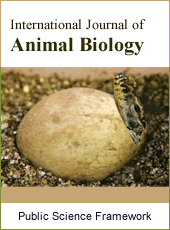International Journal of Animal Biology
Articles Information
International Journal of Animal Biology, Vol.1, No.6, Dec. 2015, Pub. Date: Jan. 21, 2016
Detection of Bioelectromagnetic Signals Transmitted Through the Exoskeleton of Living Land Snails
Pages: 302-305 Views: 3519 Downloads: 1621
[01]
Abraham A. Embi, Cardiology Department, Mount Sinai Hospital, University of Miami, Florida, USA.
[02]
Benjamin J. Scherlag, Heart Rhythm Institute, University of Oklahoma Health Sciences Center, Oklahoma City, Oklahoma, USA.
Background: Our previous reports have used a novel method for imaging bioelectromagnetic energy as electromagnetic fields (EMFs) emanating from plant and animal tissue The purpose of this study is to demonstrate that living land snails exhibit EMFs that can be transmitted through their exoskeleton and can be detected utilizing a mixture of fine iron particles and Prussian Blue Stain (PBS Fe2). Methods: Living intact land snails, 15 to 20 mm in length, were placed on glass slides, two drops of a PBS Fe2 solution were delivered under the snail’s shell. After total evaporation the snails were removed and micro-photographs of areas under the snails were viewed via a video microscope. Results: EMFs were imaged as specific patterns of iron aggregates directly under the contact area of the shell and evaporated solution; whereas such iron aggregate patterns were not observed in the presence of empty shells. Conclusions: Living gastropods, such as small snails, emit bioelectromagnetic energy in the form of EMFs transmitted through their exoskeletons to be imaged as specific patterns of iron aggregation subsequent to evaporation. No similar patterns were seen when empty shells were substituted for the live snails.
Biomagnetism, Electromagnetic Fields, Gastropods, Exoskeleton
[01]
Scherlag B J, Sahoo K, Embi A A. A Novel and Simplified Method for Imaging the Electromagnetic Energy in Plant and Animal Tissues. Journal of Nanoscience and Nanoengineering Vol 2 No.1, 2016 pp 6-9.
[02]
Embi AA, Jacobson JI, Sahoo K, Scherlag BJ Demonstration of Inherent Electromagnetic Energy Emanating From Isolated Human Hairs. Journal of nature and Science 2015; 1 e55.
[03]
Embi AA, Jacobson JI, Sahoo K, Scherla BJ. Demonstration of Electromagnetic Energy Emanating from Isolated Rodent Whiskers and the Response to Intermittent Vibrations. 2015, Journal of nature an Science, 1(3):e52.
[04]
Benjamin J Scherlag, Bing Huang, Ling Zhang, Kaustuv Sahoo, Rheal Towner, Natalya Smith, Abraham Embi, Sunny Po (2015) Imaging the Electromagnetic Field of Plants (Vigna radiata) Using Iron Particles: Qualitative and Quantitative correlates. Journal of nature and Science 1(3):e61.
[05]
Bignardi C., Petraroli M. & Pugno N. M. Nanoindentations on Conch Shells of Gastropoda and Bivalvia Molluscs Reveal Anisotropic Evolution Against External Attacks 2010 Journal of Nanocience and nanotechnology 10(10): 645-6460.
[06]
Manju Gerard, Asha Chaubey, B.D. Malhotra. Application of conducting polymers to biosensors. Biosensors and Bioelectronics Volume 17, Issue 5, May 2002, Pages 345–359.
[07]
Azuma K, Ifuku S, Osaki T, Okamoto Y, Minami S. Preparation and biomedical applications of chitin and chitosan nanofibers. J Biomed Nanotechnol. 2014 Oct; 10(10): 2891-920.
[08]
Richard Balint, Nigel J. Cassidy, Sarah H. Cartmell Conductive polymers: Towards a smart biomaterial for tissue engineering. VALIDHTML Open Access funded by Engineering and Physical Sciences Research Council Under a Creative Commons license.
[09]
Embi AA, Scherlag BJ. Human hair follicle biomagnetism: potential biochemical correlates. Journal of Molecular Biochemistry 2015; 4, 32-35.
[10]
Deheyn, D. D. and Wilson, N. G. (2011). Bioluminescent signals spatially amplified by wavelength-specific diffusion through the shell of a marine snail. Proc. R. Soc. Lond. B, doi:10.1098/rspb.2010.2203.

ISSN Print: 2381-7658
ISSN Online: 2381-7666
Current Issue:
Vol. 5, Issue 1, March Submit a Manuscript Join Editorial Board Join Reviewer Team
ISSN Online: 2381-7666
Current Issue:
Vol. 5, Issue 1, March Submit a Manuscript Join Editorial Board Join Reviewer Team
| About This Journal |
| All Issues |
| Open Access |
| Indexing |
| Payment Information |
| Author Guidelines |
| Review Process |
| Publication Ethics |
| Editorial Board |
| Peer Reviewers |


